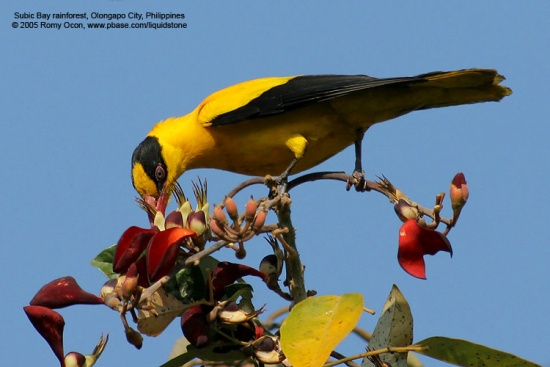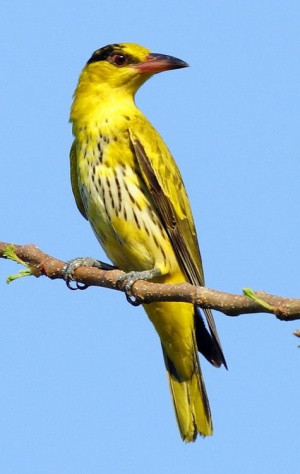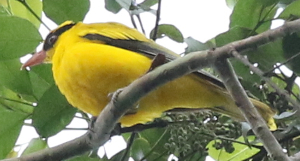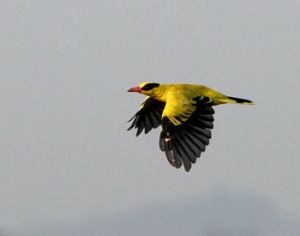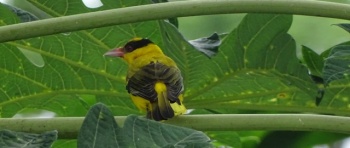m (Typo) |
(→External Links: Multiple GSearches combined) |
||
| (16 intermediate revisions by 3 users not shown) | |||
| Line 1: | Line 1: | ||
| − | [[Image:Black-naped_Oriole.jpg|thumb|550px|right|Photo by {{user|Romy+Ocon|Romy Ocon}}<br />The [[Philippines]], March 2005]] | + | [[Image:Black-naped_Oriole.jpg|thumb|550px|right|Photo © by {{user|Romy+Ocon|Romy Ocon}}<br />The [[Philippines]], March 2005]] |
;[[:category:Oriolus|Oriolus]] chinensis | ;[[:category:Oriolus|Oriolus]] chinensis | ||
==Identification== | ==Identification== | ||
| − | 23–28 cm (9-11 in | + | 23–28 cm (9-11 in)<br /> |
'''Male''' | '''Male''' | ||
*Bright golden-yellow plumage | *Bright golden-yellow plumage | ||
*Black mask extending to nape | *Black mask extending to nape | ||
*Black and yellow wings and tail | *Black and yellow wings and tail | ||
| − | [[Image:Black-naped Oriole juv.jpg|thumb|300px|right|Immature<br />Photo by {{user|linesiam|linesiam}}<br />Bangkok, [[Thailand]], April 2009]] | + | [[Image:Black-naped Oriole juv.jpg|thumb|300px|right|Immature<br />Photo © by {{user|linesiam|linesiam}}<br />Bangkok, [[Thailand]], April 2009]] |
*Pink bill | *Pink bill | ||
*Grey feet | *Grey feet | ||
| Line 16: | Line 16: | ||
From [[India]] east over [[Indochina]] to the [[Philippines]], [[Singapore]], [[Indonesia]] and eastern [[China]]. | From [[India]] east over [[Indochina]] to the [[Philippines]], [[Singapore]], [[Indonesia]] and eastern [[China]]. | ||
==Taxonomy== | ==Taxonomy== | ||
| − | The [[Slender-billed Oriole]] was considered to be conspecific but is now widely accepted as full species, including the subspecies ''invisus'' from southern [[Vietnam]], formerly placed in Black-naped Oriole. | + | The [[Slender-billed Oriole]] was considered to be conspecific but is now widely accepted as full species, including the subspecies ''invisus'' from southern [[Vietnam]], formerly placed in Black-naped Oriole. Many Black-naped Oriole subspecies probably deserve full species status since there are 9 deeply (genetically) divergent lineages [[#References|[3]]] (indicated against subspecies below). |
====Subspecies==== | ====Subspecies==== | ||
| − | [[Image:DSC00186e.jpg|thumb| | + | [[Image:Sulawesi_golden_oriole.JPG|thumb|300px|right|(sub)species ''celebensis'', "Sulawesi Golden Oriole". Photo © by {{user|THE_FERN|THE_FERN}}. Lake Tambing, Lore Lindu, [[Indonesia]], July 2023]] |
| − | Up to 20 subspecies are accepted | + | [[Image:DSC00186e.jpg|thumb|300px|right|Flight view <br /> Photo © by {{user|kelvinyam|kelvinyam}}<br />Putrajaya Wetland, [[Malaysia]], April 2009]] |
| − | * ''O. c. diffusus'': Eastern [[Asia]]; winters to [[India]], [[Malaysia]] and [[Indochina]] | + | Up to 20 subspecies are accepted [[#References|[1]]]: |
| + | * ''O. c. diffusus'': "Chinese Golden Oriole". Eastern [[Asia]]; winters to [[India]], [[Malaysia]] and [[Indochina]] | ||
* ''O. c. andamanensis'': [[Andaman Islands]] | * ''O. c. andamanensis'': [[Andaman Islands]] | ||
* ''O. c. macrourus'': [[Nicobar Islands]] | * ''O. c. macrourus'': [[Nicobar Islands]] | ||
| − | * ''O. c. chinensis'': [[Philippines|Philippine Islands]] | + | * ''O. c. chinensis'': "Philippine Golden Oriole". [[Philippines|Philippine Islands]] |
| − | * ''O. c. suluensis'': Sulu Archipelago | + | * ''O. c. suluensis'': "Philippine Golden Oriole". Sulu Archipelago |
| − | * ''O. c. melanisticus'': Talaud Islands (Karakelong and Salebabu) | + | * ''O. c. yamamurae'': "Philippine Golden Oriole". Central and southern [[Philippines]] (Tablas, Panay, Romblon, Sibuyan, Masbate, and Samar south to Mindanao) |
| − | * ''O. c. | + | * ''O. c. melanisticus'': "Celebes Sea Golden Oriole". Talaud Islands (Karakelong and Salebabu) |
| − | * ''O. c. formosus'': Siau, Tahulandang, Ruang, Biaro and Mayu island (off [[Sulawesi]]) | + | * ''O. c. sangirensis'': "Celebes Sea Golden Oriole". Sangihe and Tabuken islands (off northern [[Sulawesi]]) |
| − | * ''O. c celebensis'': [[Sulawesi]], Bangka, Talisei, Lembeh, Togian Islands, Muna, Butung | + | * ''O. c. formosus'': "Celebes Sea Golden Oriole". Siau, Tahulandang, Ruang, Biaro and Mayu island (off [[Sulawesi]]) |
| − | * ''O. c frontalis'': Banggai and Sula islands (off [[Sulawesi]]) | + | * ''O. c. celebensis'': "Sulawesi Golden Oriole". [[Sulawesi]], Bangka, Talisei, Lembeh, Togian Islands, Muna, Butung |
| − | * ''O. c | + | * ''O. c. frontalis'': "Sula Golden Oriole". Banggai and Sula islands (off [[Sulawesi]]) |
| − | + | * ''O. c. boneratensis'': "Flores Sea Golden Oriole". Tanahjampea, Bonerate, Lalaotoa, Madu and Kayuadi isla | |
| − | * ''O. c | + | * ''O. c. broderipi'': "Tenggara Golden Oriole". [[Lesser Sundas]] (Lombok, Sumba, Sumbawa, Flores, Bisar, Alor) |
| − | * ''O. c | + | * ''O. c. richmondi'': "Sunda Golden Oriole". Siberut and Pagi islands (off [[Sumatra]]) |
| − | * ''O. c | + | * ''O. c. maculatus'': "Sunda Golden Oriole". [[Sumatra]], [[Java]], [[Borneo]], Bali, Belitung and Nias islands |
| − | * ''O. c | + | * ''O. c. mundus'': "Sunda Golden Oriole". Simeulue Island (off [[Sumatra]]) |
| − | * ''O. c | + | * ''O. c. sipora'': "Sunda Golden Oriole". Sipura Island (off [[Sumatra]]) |
| − | * ''O. c | + | * ''O. c. insularis'': "Sunda Golden Oriole". Kangean Islands (Java Sea) |
| + | |||
==Habitat== | ==Habitat== | ||
| − | |||
Coastal woodlands and mangroves, farmland, parks and gardens, to 1600m. | Coastal woodlands and mangroves, farmland, parks and gardens, to 1600m. | ||
==Behaviour== | ==Behaviour== | ||
====Diet==== | ====Diet==== | ||
| + | [[Image:Black-naped OrioleDSC4219.JPG|thumb|350px|right|Subspecies ''andamanensis''<br />Photo © by {{user|Shantilal+Varu|Shantilal Varu}}<br />Portblair, [[Andaman Islands]], [[India]], November 2015]] | ||
Omnivorous, figs form a large part of their diet, along with fruit and berries. They also eat large insects, small animals and nestlings. | Omnivorous, figs form a large part of their diet, along with fruit and berries. They also eat large insects, small animals and nestlings. | ||
====Breeding==== | ====Breeding==== | ||
A cup-shaped nest is made from bark, small twigs, grass and roots. The clutch consists of two to three bluish-white eggs with brown spots which are incubated for about 14 days. | A cup-shaped nest is made from bark, small twigs, grass and roots. The clutch consists of two to three bluish-white eggs with brown spots which are incubated for about 14 days. | ||
==References== | ==References== | ||
| − | #{{Ref- | + | #{{Ref-Clements6thAug17}}#Andamanbirdwatching |
| + | # Eaton, J.A.. van Balen, B. Brickle, N.W., B Rheindk F.E. (2021). Birds of the Indonesian Archipelago, Greater Sundas and Wallacea. Lynx Edicions. Barcelona. Second Edition | ||
{{ref}} | {{ref}} | ||
| + | |||
==External Links== | ==External Links== | ||
| − | {{GSearch|Oriolus | + | {{GSearch|"Oriolus chinensis" {{!}} "Black-naped Oriole"}} |
| + | {{GS-checked}}1 | ||
| + | <br /> | ||
| + | <br /> | ||
| + | |||
[[Category:Birds]][[Category:Oriolus]] | [[Category:Birds]][[Category:Oriolus]] | ||
Latest revision as of 14:41, 28 July 2023
- Oriolus chinensis
Identification
23–28 cm (9-11 in)
Male
- Bright golden-yellow plumage
- Black mask extending to nape
- Black and yellow wings and tail
- Pink bill
- Grey feet
- Red iris
Female: duller, greenish-yellow mantle.
Juvenile: whitish underparts, blackish streaks on breast, grey bill, lacks nape band.
Distribution
From India east over Indochina to the Philippines, Singapore, Indonesia and eastern China.
Taxonomy
The Slender-billed Oriole was considered to be conspecific but is now widely accepted as full species, including the subspecies invisus from southern Vietnam, formerly placed in Black-naped Oriole. Many Black-naped Oriole subspecies probably deserve full species status since there are 9 deeply (genetically) divergent lineages [3] (indicated against subspecies below).
Subspecies
Up to 20 subspecies are accepted [1]:
- O. c. diffusus: "Chinese Golden Oriole". Eastern Asia; winters to India, Malaysia and Indochina
- O. c. andamanensis: Andaman Islands
- O. c. macrourus: Nicobar Islands
- O. c. chinensis: "Philippine Golden Oriole". Philippine Islands
- O. c. suluensis: "Philippine Golden Oriole". Sulu Archipelago
- O. c. yamamurae: "Philippine Golden Oriole". Central and southern Philippines (Tablas, Panay, Romblon, Sibuyan, Masbate, and Samar south to Mindanao)
- O. c. melanisticus: "Celebes Sea Golden Oriole". Talaud Islands (Karakelong and Salebabu)
- O. c. sangirensis: "Celebes Sea Golden Oriole". Sangihe and Tabuken islands (off northern Sulawesi)
- O. c. formosus: "Celebes Sea Golden Oriole". Siau, Tahulandang, Ruang, Biaro and Mayu island (off Sulawesi)
- O. c. celebensis: "Sulawesi Golden Oriole". Sulawesi, Bangka, Talisei, Lembeh, Togian Islands, Muna, Butung
- O. c. frontalis: "Sula Golden Oriole". Banggai and Sula islands (off Sulawesi)
- O. c. boneratensis: "Flores Sea Golden Oriole". Tanahjampea, Bonerate, Lalaotoa, Madu and Kayuadi isla
- O. c. broderipi: "Tenggara Golden Oriole". Lesser Sundas (Lombok, Sumba, Sumbawa, Flores, Bisar, Alor)
- O. c. richmondi: "Sunda Golden Oriole". Siberut and Pagi islands (off Sumatra)
- O. c. maculatus: "Sunda Golden Oriole". Sumatra, Java, Borneo, Bali, Belitung and Nias islands
- O. c. mundus: "Sunda Golden Oriole". Simeulue Island (off Sumatra)
- O. c. sipora: "Sunda Golden Oriole". Sipura Island (off Sumatra)
- O. c. insularis: "Sunda Golden Oriole". Kangean Islands (Java Sea)
Habitat
Coastal woodlands and mangroves, farmland, parks and gardens, to 1600m.
Behaviour
Diet
Omnivorous, figs form a large part of their diet, along with fruit and berries. They also eat large insects, small animals and nestlings.
Breeding
A cup-shaped nest is made from bark, small twigs, grass and roots. The clutch consists of two to three bluish-white eggs with brown spots which are incubated for about 14 days.
References
- Clements, J. F., T. S. Schulenberg, M. J. Iliff, D. Roberson, T. A. Fredericks, B. L. Sullivan, and C. L. Wood. 2017. The eBird/Clements checklist of birds of the world: v2017, with updates to August 2017. Downloaded from http://www.birds.cornell.edu/clementschecklist/download/
- Andamanbirdwatching
- Eaton, J.A.. van Balen, B. Brickle, N.W., B Rheindk F.E. (2021). Birds of the Indonesian Archipelago, Greater Sundas and Wallacea. Lynx Edicions. Barcelona. Second Edition
Recommended Citation
- BirdForum Opus contributors. (2024) Black-naped Oriole. In: BirdForum, the forum for wild birds and birding. Retrieved 9 May 2024 from https://www.birdforum.net/opus/Black-naped_Oriole
External Links
GSearch checked for 2020 platform.1




